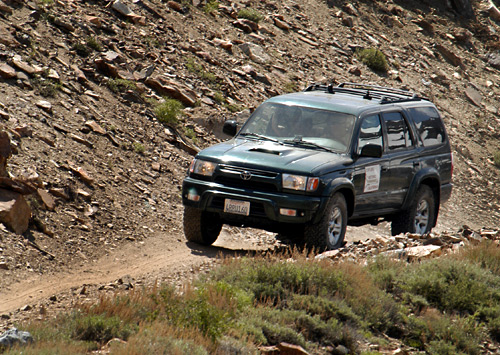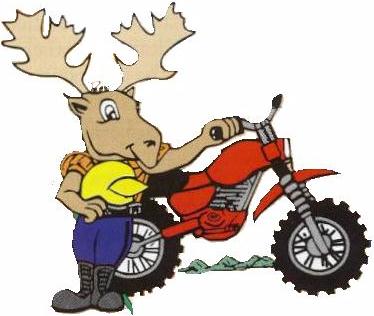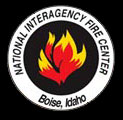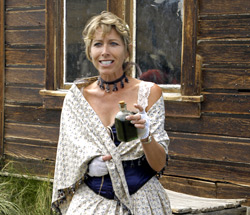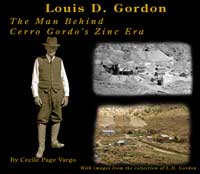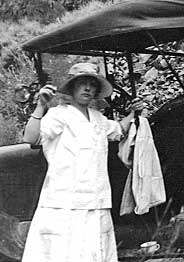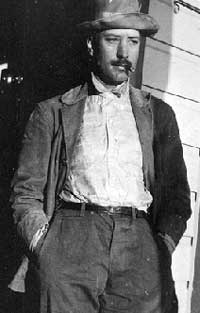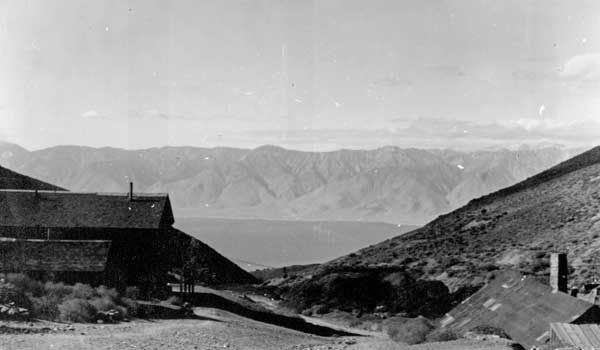|
|

|
We Found Her!
|
|||||||||||||||||||||||||||||||||||||||||||||||||||||||||||||||
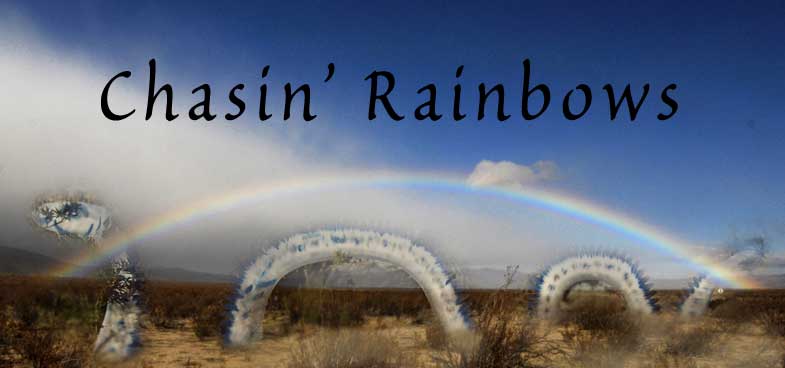 We apologize for the delay in getting our February issue on line, but we've been out chasing rainbows and Nessie in the desert. Look for more about Nessie in April. |
||||||||||||||||||||||||||||||||||||||||||||||||||||||||||||||||
|
Cornelia Gordon Remembers by Cecile Page Vargo |
||||||||||||||||||||||||||||||||||||||||||||||||||||||||||||||||
|
The following is an excerpt from "Louis D. Gordon--The Man Behind Cerro Gordo's Zinc Era," presented at the Eighth Death Valley History Conference, January 31-February 2, 2008.
Sometime in the 1970’s a tape recorder was handed to the first Mrs. Louis D. Gordon. With the help of a nurse on duty at the retirement home Cornelia now called her place of residence, she managed to “tame” the thing, and began to speak into it, giving us insight to a more personal side of the man and the life he and his family lived: “In 1906, I was married in Plainfield, New Jersey, to a man who was born in Austin, Nevada, and very interested in mining and geology.”
“He went to school in San Francisco, and then had two years at the Annapolis Naval Academy, but left before graduation, as he was anxious to get back to the West. We met in Point Pleasant, New Jersey, and became engaged. I had to wait two years to be married, because he had staked a claim and he had to get back out west. However, we finally got married, and bought a house in Salt Lake and after about a year and a half we went to the first mining camp which was Gold Circle in Midas, Nevada.” “The camp was really just a camp; there were no houses except two stores down in the village which had false fronts where they sold meat and groceries and some yard goods and then there was a hotel with a false front and the back of it, I imagine, was a tent because you could hear everything so clearly that was being said in the room next to you.” “The first night we went to Gold Circle there were two drunks in the room next to us and they were using obscene language and my husband spoke to them and said, ‘If you don’t stop talking like that, I have my wife here, I will throw you downstairs.’ Well, they didn’t stop and so he threw them downstairs. That was my first dramatic experience.”
From Gold Circle, the Gordons settled in Salt Lake City, Utah. Their first trip together from Salt Lake was to Mexico, “as there was a mine to be unwatered” and “L” was requested to come and look at it. Cornelia was not allowed to go to the mine; she had to stay in a little hotel in Agua Caliente, since there were no feminine accommodations up in the mountains. This was during rainy season, the room was cold and the sheets on the bed were damp. Hotel staff would build a fire for her and pull the sheets off so they could dry before she slept on them, without worry of getting pneumonia. Toilet facilities were discovered by way of flashlight down the hall, and described as a “3-holer, Chic Sale”* with resident cockroaches. After five or six days alone, Louis had completed his tasks at the mine and Cornelia was finally rescued. From Agua Caliente, the Gordons headed by train to Mexico City. Following a mishap with a hand car, four workmen and an overturned rail car complete with pandemonium, but no wounded, they settled in a comfortable hotel. Each afternoon around 5 o’clock they watched open carriages on the very narrow streets passing others going in the opposite direction. The Gordon’s noted beautifully dressed women wearing mantillas and a great deal of face powder, smiling and bowing to each other. Though the streets barely had room for the harrowing passage, it was obvious the American couple were witnessing a very important Mexican rite. Louis and Cornelia enjoyed their sightseeing in Mexico and then returned to Salt Lake City until their next trip to Round Mountain. “Round Mountain, Nevada is in Nye County, 60 miles from Tonopah and on the desert…” an elderly Cornelia speaks into the tape recorder once again. “We drove the first trip we made and the mine is on the sunny side of the mountain and has a stamp mill where the very high grade ore is treated and an office building with quarters on top for family, which in later years when I came out and took the children we occupied. The ore is very rich and very high grade, and was made into gold bullion at the stamp mill and then taken to Tonopah and shipped by train to a smelter…The water for the placer came from a canyon up in the Black Mountains - Jet Canyon - and the mine was both placer and lode.” “...Mining engineers from all different parts of the country would often come out to the mine because it was a very unusual development, both placer and lode, and very high-grade ore. So there were many interesting contacts with people, and life was far from dull. Sometimes there were dances on a Saturday night and the Indians would come. We had a man to play the piano and a violinist, and it was real old fashioned country goings-on.
I danced with the Indians and it was a little tricky because they were not too careful about their person, and the weather was hot, but anyway, it was something to do and a little different.” Around 1911, Cornelia Gordon was visiting friends in Los Angeles when word came that her husband, Louis, had obtained the lease on an old worked out silver lead mine in Inyo County, known as Cerro Gordo. The trek from Los Angeles to Keeler at the base of the mountain would be an arduous one, but paled in comparison to the 23 per cent winding incline up the Yellow Grade Road, where no automobiles had ever gone. The little Gordon family was packed and ready to head across the vast Mojave Desert from Los Angeles when Louis learned he would be detained by business. Cornelia and son boarded the train alone to Mojave, laid over a night in a boxcar there, then on to Keeler. From Keeler she boarded a wagon which would take her up the infamous Yellow Grade Road. In the seat behind her, another person sat, holding an umbrella for shade. Somewhere along the precipitous eight mile journey, they would stop to make a fire to warm the baby’s bottle for feeding time.
Nearly at the top of the mountain peak, Cornelia and party arrived at the Cerro Gordo Mines. As they stepped out of the wagon, they turned to the view of Keeler down below. Cornelia described the view of the “dry soda lake turned the most heavenly blue... blue as sapphire” with Mount Whitney towering in the distance. A sad looking cabin was provided for the Gordons to live in until a more comfortable house could be built. The little place was so dirty, Cornelia had to get miners to scrub the walls and take up the horrible matting on the floor. Old green carpeting, brought in from Los Angeles, was put down on the floor, and a nice table was provided to sit and have meals, soon making the place quite homey indeed. Behind the cabin there was a bathroom, with a galvanized zinc tub. Water was heated and brought in from elsewhere, since there were no pipes. When Louis finally arrived on the mountain, he was quite surprised to see his wife, son, and the accompanying nursemaid content in their humble quarters. Cornelia recalled, “We had one Christmas up at the mine…and it was very pretty with snow all around…The wind was always very bad and very blustery.”
“L”, as Cornelia called her husband, would be gone all day, then take off again after a 5 p.m. dinner and go back down into the mines for the evenings. She longed for good conversations or book reading together, but there was never time for it. With no housekeeping facilities in her little cabin, she did manage to cook for the baby, get breakfast and a light lunch, and then a fine dinner would often be had at the house of one of the wives of the other miners, relieving her loneliness. The Gordons lived on the mountain on and off from 1911 to 1920. Louis was more often than not, busy tending to the business of the Cerro Gordo Mines Co., or off the mountain at one of his other holdings. Cornelia and son learned to entertain themselves when they could, astride horse or hiking on the mountain, enjoying the beautiful backcountry scenery and the wildflowers as weather permitted. Eventually, a suitable home was built for the family to take the place of the primitive cabin they originally lived in. It had as many modern conveniences for the time period as could be expected on an isolated mountain top. The ore tramway often provided communication to the outside world when modern means failed or just plain weren’t in existence. Cornelia would put her grocery list on a bucket headed down the mountain, and it would come back with her requests, including baby formula. Cornelia had known from the early days of her marriage that she and Louis would call the God forsaken mining camps their home. The primitive tent camp of Gold Circle had well rehearsed the Gordons for what lay ahead of them in California’s Inyo Mountains, as well as times yet to come in other mining areas of Nevada, Utah, and Mexico, where Louis also had interests. Three children and a divorce several years later would send Louis and Cornelia in separate directions. But Cornelia fondly remembered the tales of their early years together. Bibliography From This Mountain Cerro Gordo by Robert C. Likes and Glenn R. Day Community Printing and Publishing, Bishop
A Guide To The Ghosttowns And Mining Camps Of Nye County Nevada by Shawn Hall Dodd, Mead & Co New York
Cerro Gordo Bugle of Freedom Special Edition, March 1996 by Michael A. Patterson Cerro Gordo, Ghosttown
Cornelia Goes To Cerro Gordo by Cecile Page Vargo Explore Historic California website, July 2007
Historic Legends of Inyo County, A Bi-Centennial Book “The Town That Built Los Angeles -Cerro Gordo” by Fred S. Cook California Traveler, Inc., Pioneer, Calif.
Images from the L. D. Gordon Collection, courtesy Douglas Gordon.
|
||||||||||||||||||||||||||||||||||||||||||||||||||||||||||||||||

